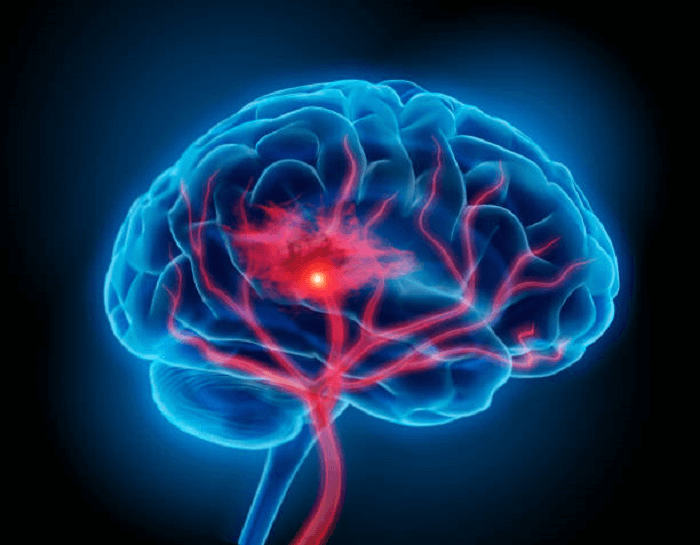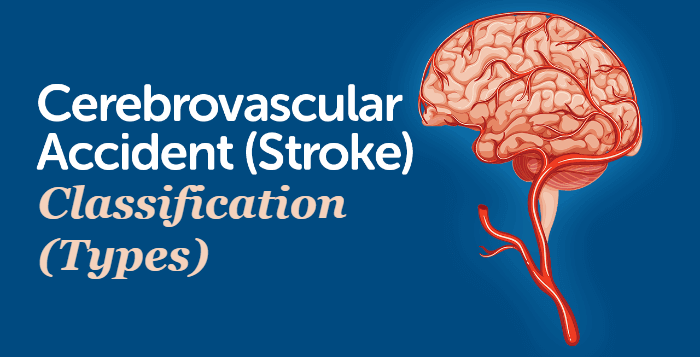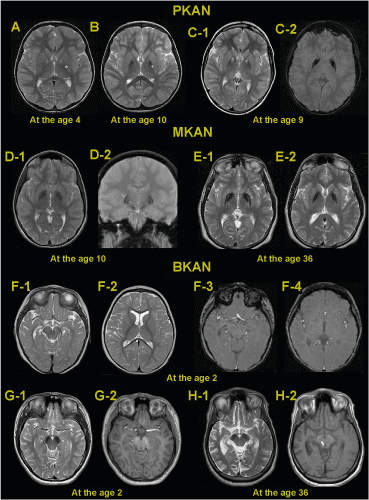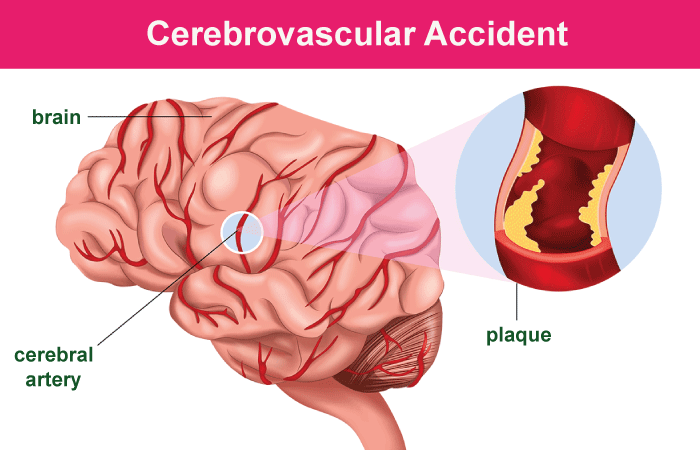CVA DefinitionCVA stands for Cerebrovascular Accident. A cerebrovascular accident occurs when the blood stops flowing in some part of the brain due to the blockage or tearing of a blood vessel. The person may experience numbness in any part of the body or may experience dizziness. This medical condition is commonly known as a stroke. 
In some specific cases of CVA, the subject (typically human) dies due to oxygen deficiency in brain cells. CT and MRI scans of the brain can be used to diagnose a person with a CVA because these machines produce images to demonstrate whether bleeding or nerve damage has occurred inside the brain. This helps in treating the CVA accordingly. CVA is a critical medical condition as there is no surety how long the person experiencing a stroke will survive. Types of Cerebrovascular AccidentsIn all cases of strokes, the brain partially stops functioning due to a lack of oxygen. Notably, CVAs (strokes) are categorized into two primary categories, such as ischemic or hemorrhagic. However, there are five common categories of CVAs based on the damage they do to the human brain and the conditions in which they occur. These categories of CVAs are explained below: 
Ischemic StrokeA stroke that occurs when the brain cells stop getting oxygen because the blood supply towards the brain has been reduced or barricaded is known as Ischemic stroke. Ischemic stroke is the general type of stroke that patients most often experience. As people get older, their arteries start narrowing and becoming so thin that they block the blood from passing through them, resulting in a CVA. Another cause of ischemic stroke is blocked arteries due to fatty particles. This process is called the "hardening of arteries" or atherosclerosis. Transient Ischemic Attack (TIA)TIA is the medical term used for 'Mini Attack'. A stroke that occurs only for a few minutes is known as Transient Ischemic Attack. Due to blood clotting, the partial blood supply proceeding towards the brain is stopped but only for a short period, and this is when the mini-stroke takes place. Soon the clot dissolves, and the person's body starts functioning naturally. These mini-strokes are often taken as warning signs for a critical stroke in the future. Hemorrhagic StrokeA stroke that transpires due to the bursting of a blood vessel in the brain is a Hemorrhagic stroke. As a result of head injuries or concussion, the blood flowing from the ruptured blood vessel fills the spaces of the brain, proceeding into a stroke. The most common cause of Hemorrhagic stroke is hypertension. Brainstem StrokeDuring a brainstem stroke, the blood supply at the bottom of the brain is stopped. This stoke is listed as a life-threatening health emergency. Brainstem is found in the front of the cerebellum in the brain, which is connected to the spinal cord. Due to this connection, defects occur in involuntary body functions, such as heart rate, blood pressure, and breathing. Cryptogenic StrokeThe identification of the type of stroke is important for proper treatment. However, in 30-40% of stroke cases, patients are not able to recognize the stroke. The term used for these strokes is cryptogenic strokes, as no definite cause can be found for their happening. Tests Involved in Detecting StrokeFirstly, when the patient reaches the hospital, the doctors must identify the cause or type of CVA. Also, doctors need to confirm that the experienced stroke is not due to a brain tumor, drug reaction, or other conditions that must be dealt with. Therefore, an immediate CT scan must be done. Several important tests can be performed to detect the patient with CVA and diagnose them accordingly. Some common tests include the following: Physical TestBasic physical checkups such as observation of patients' heartbeat and measuring their blood pressure are noted at first. A neurological test is also done to determine if the stroke has done any major damage to the nervous system. Blood ReportsBlood tests are run on the patient to detect infections, sugar levels, and rate of blood clotting. CT ScanThe X-rays or scanned images of the brain are developed through Computerized Tomography, called CT Scan. These scans can clearly locate a tumor and blood clots in the brain. To perform this test, doctors inject the person with a dye so that the X-rays appear more detailed. MRI ScanningRadiowaves are passed through the patient's brain, and magnets are used to get a better view. The tissue damage, injuries, and brain hemorrhages can all be detected through MRI. Dye is used in the blood vessels to highlight the blood in arteries and veins. 
Doppler UltrasoundThe sound waves are used inside a patient's neck, where the arteries and veins that connect to the brain can be located. This test examines the blood flow in the blood vessels and reveals the fatty deposits that might be blocking them. ElectrocardiographyThe electrocardiogram creates scanned images of the heart of the patient by using electric signals. A stroke can be caused if the source of blood clots travels from the heart toward the brain. Symptoms of CVAIf a person experiences CVA, the chances of major brain damage increase with each passing minute. Therefore, it is important to know the symptoms of stroke to take action rapidly. The following symptoms are usually observed if a person is experiencing a stroke:
According to the American Stroke Association, a person experiencing FAST effects of a CVA should call 911 immediately. FAST is a test that should be performed to know if someone is actually going through a CVA. FAST is the abbreviation for:
All the symptoms mentioned above must be discovered before determining the individual's condition as stroke. For instance- the dizziness may also be caused by vertigo, motion sickness, and medications. Likewise, blurry vision may occur due to nearsightedness. Therefore, several factors (symptoms) must be taken into account simultaneously. Anyways, medical attention is necessary, and a paramedic team should be called at once after the person starts showing signs of CVA. Causes of CVA
The occurrence of stroke greatly depends on a person's diet and lifestyle. Several factors can increase the risks of CVA if left unchecked. The following factors may help in decreasing the risks of strokes and even treating them in specific instances: ObesityAn overweight person has more chances of experiencing a stroke than a healthy person. Consuming a high amount of animal fat (not extracted from dairy sources) magnifies the chances of stroke. Also, make sure you exercise regularly and avoid fatty food to prevent the occurrence of CVA. High Consumption of Illegal Drugs such as Opium or CocaineAddictive drugs can cause major damage to blood vessels in the brain and heart. This increases the blood pressure of a person, which could lead to stroke. IdlenessIf a person sits all day and does no physical labor, the fatty deposit starts to collect inside his body. This leads to the clogging of arteries, and some blood vessels connected to the heart get damaged. This gives way to a heart attack. If similar damage happens to the blood vessels carrying blood to the brain, a stroke occurs. Therefore, inactivity can also be seen as a health hazard that may progress toward stroke. Rise in Blood PressureThe average age for a person to experience high blood pressure is 64 in men and 65 in women. Blood cells die due to increased blood pressure as it causes the arteries in the brain to burst, and so the stroke occurs. SmokingTobacco contains approximately 4000 toxic chemicals that get dissolved in the bloodstream through the lungs. Also, smoking increases the number of triglycerides and lessens the good cholesterol in the blood. Due to this, the blood gets sticky and starts forming clots, blocking the blood pathways toward the brain and heart. This is why stroke may occur. DiabetesDiabetes is the common cause of stroke in patients. The pathologic changes in the blood vessels are caused by diabetes. If the cerebral vessels are directly affected by diabetes, the risk of getting a stroke is doubled. The condition of a diabetic person gets worse after a stroke as the sugar levels get more imbalanced. Difficulties Experienced by CVA PatientsBased on the damage to the brain and blood vessels, temporary or permanent dysfunctions may be experienced by the person. Several complications that arise due to stroke are given below: Emotional DilemmaThe brain is an essential part that controls the thoughts and emotions of an individual. If a person has gone through a CVA in the past, it can majorly affect his/ her moods and emotions. People even suffer from depression after a traumatic experience like a stroke. Stroke patients can experience sudden and uncontrollable crying instances due to motor imbalances. ParalysisAlong with mental defects, stroke victims might suffer from physical disabilities as well. People have complained about muscle weakness, stiffness, and changes in bodily sensations. In the worst case, the person may even become paralyzed. Daily activities that require muscle movements get harder to accomplish for these individuals. Dementia and Difficulty in Thinking ClearlyIndividuals who have gone through a CVA might experience short spans of memory. For example- they might forget the address to their homes or wake up with no memories of past happenings. Vascular dementia is the type of dementia that takes place after a stroke. A diagnosis of vascular stroke can be made in a person only if no other cause of dementia is found in him/ her, which may result from brain damage. Speech Disability and Problems in Swallowing foodA stroke can cause permanent speaking disability or slurred speech in a person. A left hemisphere stroke can result in a speech defect because the part which controls a person's dialect lies in the brain's left hemisphere. The coordination of speech muscles gets disorganized, and the individual can feel their speech muscles getting tired quickly. Stroke survivors often have problems performing activities associated with languages, such as reading, writing, understanding words, etc. Pain and NumbnessStroke can cause victims to experience muscle pains and numbness in different body regions. These instances occur due to nerve damage that is the result of a stroke. If the muscle gets contracted for long periods, a person might feel high pain sensations. The involuntary tightness of muscles is known as hypertonia. Numbness or tingling sensations in arm and leg muscles are other aftereffects of CVA. Preventive Measures to Avoid CVABy adopting a healthy lifestyle and following the guidance of a healthcare instructor, the risk of CVAs can be decreased. If one has experienced a stroke earlier in life, he/ she needs to take quick action to avoid a second stroke. The following measures may be taken to prevent further incidents of CVA: Medicating Obstructive Sleep ApneaObstructive sleep apnea is a sleep disorder during which a person might feel difficulty breathing while sleeping. This condition occurs due to the complete or partial subsidization of the upper nasal airway. Because of this, the oxygen saturation is decreased, resulting in hypoxemia. Doctors recommend oxygen therapy and devices that provide the right amount of air pressure to open oxygen pathways for curing sleep apnea. Regular and comfortable sleep could be achieved by using these methods, which may effectively prevent strokes. Keep the Blood Pressure in CheckThis is an essential step for reducing stroke risk. Arteries can get ruptured due to high blood pressure. Therefore, maintaining low blood pressure can lower the occurrences of mini-strokes. Medications can assist in decreasing high blood pressure. Eating a Balanced DietBy eating fruits 4-5 times per day, nutrients such as vitamins, iron, proteins, and so on can be gained, which increases a person's immunity. The Mediterranean diet of olive oil, vegetables, fruits, dry fruits, and whole grains is advised for maintaining good health. Controlling Alcohol ConsumptionHigh ingestion of alcohol can lead to high blood pressure. High blood pressure can increase the chances of ischemic strokes and TIAs. If an individual is on medication and consumes alcohol along with it, the side effects can be critical. However, a small amount of alcohol, on a doctor's advice, can sometimes help prevent a CVA as well. ConclusionAs concluded, cerebrovascular accident (CVA) is nothing but the medical term used to refer to stroke. Stroke generally refers to the scenario when the blood flow to a part of your brain is stopped either due to blockage or rupture of a blood vessel. CVA is a critical occurrence, and individuals who go through it must live with its aftereffects and fear that it might happen again to them or their loved ones. So, take these instances seriously and maintain a healthy lifestyle to prevent CVAs.
Next TopicDictatorship Definition
|
 For Videos Join Our Youtube Channel: Join Now
For Videos Join Our Youtube Channel: Join Now
Feedback
- Send your Feedback to [email protected]
Help Others, Please Share










